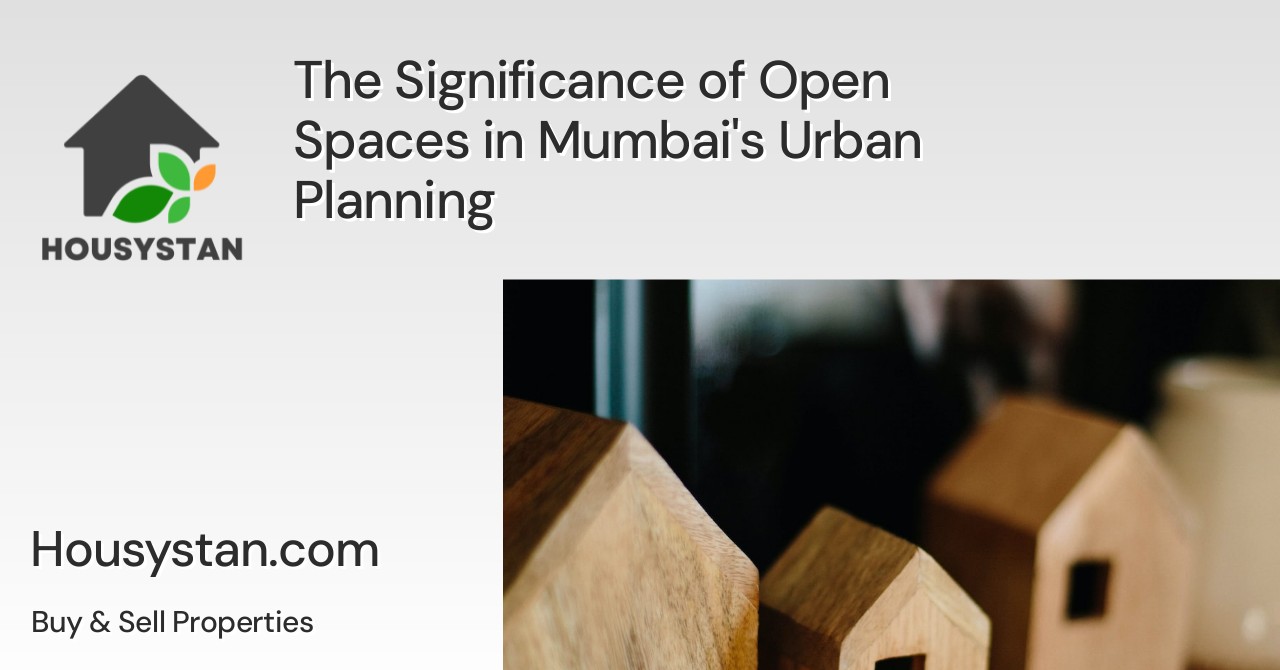The Significance of Open Spaces in Mumbai's Urban Planning
Read latest blogs and articles from Housystan

The Information mentioned here was last updated on:
4/12/2025The Significance of Open Spaces in Mumbai's Urban Planning
In the bustling metropolis of Mumbai, a city known for its vibrant culture and endless hustle, open spaces serve as essential oases amidst the urban chaos. These open spaces—be it public parks, gardens, beaches, or playgrounds—play a vital role in enhancing the quality of life for residents while also contributing to the city’s ecological health. Let's delve into the multifaceted significance of open spaces in Mumbai's urban planning.
Why Open Spaces Matter in Urban Areas
- Verified Tenants/Buyers
- Unlimited Property Listing
- Zero subscription/charges fee
Open spaces are indispensable to any urban area for several reasons. Here are a few key aspects that underscore their importance:
- Mental Well-being: Studies have consistently shown that exposure to nature and greenery can reduce stress, anxiety, and depression. In a densely packed city like Mumbai, open spaces provide a much-needed escape from the frenetic city life.
- Physical Health: Open areas encourage physical activity, which is crucial for maintaining good health. They serve as venues for exercises such as walking, jogging, yoga, and community sports.
- Social Cohesion: Open spaces offer a place for community interactions, leading to stronger neighborhood ties and improved socializing opportunities for residents of all ages.
The Current State of Open Spaces in Mumbai
Despite their importance, Mumbai’s open spaces are limited and often underutilized. Several factors contribute to this scarcity:
- High Population Density: With over 20 million people, the pressure on the available land is intense, leading to an inadequate number of parks and gardens relative to the population.
- Urbanization Pressure: The relentless pace of urbanization and real estate development often takes precedence over the creation and maintenance of open spaces.
- Poor Maintenance: Many of Mumbai's existing parks and playgrounds suffer from neglect, with inadequate facilities and infrastructure.
The Role of Open Spaces in Urban Planning
Urban planners in Mumbai face significant challenges in integrating open spaces into their schemes, yet this integration is crucial for a sustainable city environment. Here are some core principles and strategies employed in urban planning:
- Green Networks: Planning for interconnected open spaces or green corridors can enhance ecological balance, improve connectivity, and bolster the city’s biodiversity.
- Multi-Use Spaces: Designing flexible spaces that serve multiple functions—such as sports complexes integrated with parks—can maximize utility and appeal to a broader audience.
- Public-Private Partnerships: Collaborations between the government and private entities can bring in additional resources for the development and maintenance of open spaces.
Notable Open Spaces in Mumbai
Mumbai boasts a range of notable open spaces that contribute significantly to the city's landscape. Some of these spaces serve as exemplary models for urban planning:
- Marine Drive: This iconic boulevard provides stunning views of the Arabian Sea. It is a popular jogging track and an ideal spot for relaxation.
- Sanjay Gandhi National Park: Located on the outskirts of the city, this sprawling park offers hiking trails, dense forest cover, and is a haven for local wildlife.
- Oval Maidan: A popular ground for cricket and other sports, it is a vibrant example of how open spaces can be utilized for recreational purposes.
Open Spaces and Environmental Benefits
Open spaces are not merely for recreation and socialization; they also offer substantial environmental benefits:
- Air Quality Improvement: Vegetation in parks and gardens helps in reducing air pollution by absorbing pollutants and releasing oxygen.
- Urban Heat Reduction: Green spaces help mitigate the urban heat island effect by reducing ground temperatures and providing cooling through shade and evapotranspiration.
- Biodiversity Support: Open areas serve as habitats for various species of flora and fauna, playing a crucial role in the city's ecological diversity.
Challenges and Solutions
Addressing the challenges related to open spaces in Mumbai requires innovative solutions and commitment from all stakeholders. Here are some strategies and recommendations:
- Increased Green Cover: Encouraging vertical gardens and rooftop gardens can enhance greenery without requiring additional land.
- Community Participation: Engaging local communities in the development and maintenance of open spaces ensures their sustained utility and relevance.
- Legislation and Policy: Stronger policies and regulations that prioritize open space creation and conservation within urban development projects are essential.
How Technology Can Help
Technology can play a pivotal role in optimizing the use and maintenance of open spaces:
- Mobile Apps: Applications that provide information about nearby open spaces, activities, and events can enhance public engagement.
- Drone Surveillance: Drones can be employed for monitoring the condition and usage of large parks and gardens, enabling better maintenance.
A Vision for the Future
The future of urban planning in Mumbai must integrate a vision where open spaces are prioritized alongside infrastructure development. Key objectives should include:
- Equitable Distribution: Ensuring that all neighborhoods, irrespective of socioeconomic status, have access to well-maintained open spaces.
- Scalable Solutions: Urban planning must accommodate future growth while maintaining green spaces, balancing development with sustainability.
- Innovative Urban Design: Embracing novel concepts such as green roofs, urban farming, and eco-friendly architecture can revolutionize how open spaces are perceived and utilized.
In closing, while urban planners in Mumbai face immense challenges, the deliberate and strategic incorporation of open spaces into the city’s urban fabric is crucial. Not only do these spaces enrich the lives of residents, but they also play a fundamental role in shaping a sustainable and livable environment for future generations. By addressing existing challenges and leveraging modern technology and inclusive policies, Mumbai can transform its urban landscape into one that thoughtfully integrates both green spaces and development.
By focusing on these elements, readers can gain a comprehensive view of how open spaces contribute to more than just the urban aesthetic—they are vital components of a city's well-being and sustainability strategy.